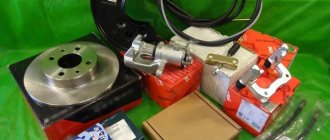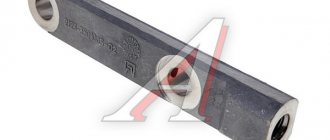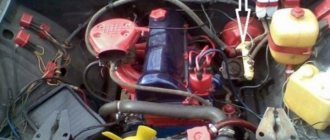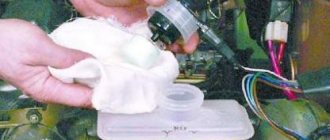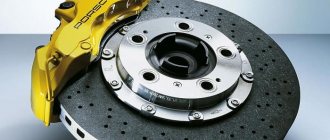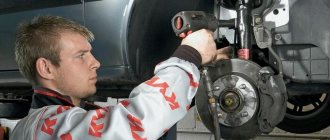Concepts of stopping and braking distance
Regardless of the level of professionalism of the person driving the car, when driving, situations arise that force the vehicle to stop. And this must be done very quickly. It can be:
- Failure of a vehicle unit (component) that affects traffic safety.
- Obstacles on the roadway (stones, holes, fallen trees).
- The unexpected appearance of a person (animal) on the road.
- Creation of an emergency situation by other traffic participants.
The occurrence of any of the situations forces the driver to apply emergency braking of the car. However, it is known from the basics of physics that any moving body continues its forward motion for some time, obeying the force of inertia. That is, it travels a certain distance.
The braking distance of a car is the distance traveled by it in a period of time limited by the moment the brake system is activated and the moment it comes to a complete stop. This time period is the “braking distance time.”
But the car is not driven by a robot, but by a person who needs time to analyze the situation and make a decision, or reaction time, during which the car continues to move, going through the reaction path.
From the moment the need to stop arises until the stop, the vehicle will travel a distance equal to the sum of the reaction distance and the braking distance. This is the stopping distance of the car, and the time it travels is called the stopping distance.
How to increase the intensity of deceleration
From the above, it became clear what is called the braking distance and what this indicator depends on. However, is it possible to reduce the distance required to stop a car? Maybe! There are two ways to do this - behavioral and technical. Ideally, the driver combines both methods.
- Behavioral method - you can reduce the braking distance if you choose a low speed on slippery and wet roads, take into account the degree of load of the car, and correctly calculate the braking capabilities of the car depending on its condition and model year. Thus, a Moskvich developed in 1985 will not be able to brake as effectively as a modern Hyundai Solaris, not to mention more respectable and technologically advanced models.
- Technical method - a method of enhancing braking capabilities, based on increasing the power of the braking system and the use of auxiliary mechanisms. Manufacturers of modern vehicles actively use such methods of improving brakes, equipping their products with anti-lock braking systems, braking assistance systems, using more efficient brake discs and pads.
It should be remembered that reducing the time required to stop is one of the ways to ensure a safe trip. Therefore, every driver must constantly monitor the technical condition of his “iron horse”, promptly maintain and repair the braking system. In addition, it is important to choose the driving speed taking into account the surrounding situation: time of day, road condition, car model, etc.
Car braking distance formula
Situations often arise that require you to find out the braking distance of a car. This is necessary when:
- conducting forensic examination (for example, in the case of an accident);
- control checks of modified brake systems;
- testing of vehicles put into mass production.
The braking distance is calculated using the formula:
The adhesion coefficient is not a constant value, since its value depends on the condition of the road surface. The table below shows average Fs values for the main types of road conditions.
| Coating condition | Numerical value of the coefficient |
| icy | 0,1 |
| snowy | 0,2 |
| wet | 0,4 |
| Clean and dry | 0,7 |
Example No. 1 : A car is moving along a snowy road at a speed of 100 km/h. At a distance of one hundred meters, the driver notices a sudden obstacle and begins braking. S = (1/ (254 • 0.2)) • 1002. Using simple calculations, we obtain the braking distance of the car equal to 196.85 meters.
Summary: The collision could not be avoided.
How to find braking speed formula
It is known that a truck weighing five thousand kilograms moves along a horizontal path at a speed of seventy-two kilometers per hour (20 meters per second).
Required: determine the force and time of braking of the car if the braking distance is five meters. Given: m=5000 kg; v=20 m/sec; s=5 m Find: F-?; t-?
Based on the fact that the work of the braking force is numerically equal to the change in the kinetic energy of a moving car
, we get the formula for determining the braking force
Substituting numerical values into the formula, we calculate the braking force of the truck
n
From the formula
, provided that vt=0: , where , we obtain the formula for braking time
Vehicle braking time
sec
Answer: the braking force of the car was two hundred thousand newtons, the braking time was equal to half a second.
Braking distance is the distance it takes for a vehicle to come to a complete stop from the moment the braking system begins to operate.
In everyday life, this term is often confused with stopping distance, but braking distance and stopping distance are different concepts. In the latter case, the distance elapsed from the moment the driver realized the need to brake to a speed of 0 km/h is taken into account. The braking distance is part of the stopping distance.
Factors affecting braking distance
There are two groups of reasons that influence the braking distance of a vehicle. The first includes reasons whose occurrence does not depend on the person driving the car. This is the condition of the road surface and weather conditions. Without being able to influence them to any extent, the driver must take them into account when choosing speed and distance.
The second group of reasons depends on the driver of the car. They should be treated more carefully.
Speed
The influence of the speed limit on stopping and braking distances is so great that traffic rules set strict restrictions regarding the movement of vehicles in populated areas, residential areas, etc. The average braking distance of a car at a certain speed was determined experimentally. These values in the table are correct for the most favorable driving conditions: a technically sound vehicle, optimal weather conditions, good road surface.
| Vehicle speed, km/h | Braking distance of a car moving at a specified speed in case of emergency braking, m |
| 50 | 16,3 |
| 60 | 23,5 |
| 70 | 32,1 |
| 80 | 42,0 |
| 90 | 53,0 |
| 100 | 65,5 |
As can be seen from the table, there is a significant increase in the braking distance of a vehicle depending on its speed.
When choosing your speed, consider another important aspect. This is the driver's reaction speed. And if the time spent on making a decision is approximately the same for the vast majority of drivers, then the higher the speed, the longer the braking distance.
Weather and road conditions
Changing weather conditions can significantly increase braking time.
Example No. 2 : A car moving along a dry road at a speed of 80 km/h enters a strip of heavy rain. On wet roads, the coefficient of adhesion decreases from 0.7 to 0.4. Applying the well-known formula, we obtain: S = (1/ (254 • 0.4)) • 802. The braking distance was 62.99 meters, that is, it increased by one and a half times.
Technical condition of the car
Technically sound vehicles are allowed to participate in road traffic, as stipulated in clause 11 of the traffic rules. A list of faults has been developed that prevent the vehicle from participating in road traffic. And the braking system occupies one of the key places in this list. The components and assemblies of this system are directly involved in stopping the car. Worn brake linings and pads, deformed and worn-out brake drums (discs), used brake fluid, due to the loss of part of its physical and operational characteristics, significantly increase the length of the stopping distance.
The role of tires is no less important, since they provide traction between the car and the road surface. Tire pressures that differ from those recommended by the manufacturer increase braking distance. As well as a worn out, “bald tire”. Insufficient tread depth prevents effective water drainage and creates a film of water between the car wheel and the road surface, creating the effect of aquaplaning.
As a result, the vehicle “floats”, losing control.
Dirty windows and lights reduce visibility, increasing the time it takes to make a decision, which negatively affects the time it takes to come to a complete stop.
Design features of the car
To the possible chagrin of adherents of the theory about the shorter braking distance of a car with ABS (anti-lock braking system), the opinion of experts on this matter is the opposite. The table shows the results of testing a passenger car driving at a speed of 50 km/h in various road conditions.
| Road surface condition | Braking distance, m | |
| with ABS | without ABS | |
| black ice | 19,0 | 12,0 |
| snow porridge, ice, unevenness | 25,0 | |
| loose snow | 23,0 | |
| asphalt (dry) | 7,5 | 10,0 |
| asphalt (wet) | 11,0 | 9,0 |
Road surface condition
The presence of ABS reduces the stopping distance only on dry asphalt surfaces. Its key advantage lies elsewhere: in maintaining complete control over the car throughout the entire braking distance. The driver does not need to calculate the pressure on the brake pedal. The system independently selects the optimal stopping mode depending on the conditions.
Basics of Vehicle Braking Dynamics
Braking torque
The braking torque can be determined by the formula:
where υт is a proportionality coefficient that varies widely and depends on many factors - temperature, presence of water, etc.); P – pressure in the brake drive.
Braking force
The sum of the braking forces on the braked wheels provides braking resistance. Unlike natural resistances (rolling resistance force or rolling force), the braking force can be adjusted from zero to a maximum value corresponding to emergency braking.
If the braking wheel does not slip on the road surface, then the kinetic energy of the car goes into the work of friction of the braking mechanism and partially into the work of natural resistance forces. During intense braking, the wheel can be blocked by the braking mechanism, then it skids along the road and friction occurs between the tire and the supporting surface.
As the intensity of braking increases, the energy spent on tire slipping increases, resulting in increased tire wear. Tire wear is especially high when the wheels lock on paved roads and at high sliding speeds. Braking with wheel locking is also undesirable for traffic safety reasons, since on a locked wheel the braking force is significantly less than when braking on the verge of locking. In addition, when sliding on the road, the car loses controllability and stability.
The limiting value of the braking force is determined by the coefficient of adhesion φx of the wheels with the road:
For all wheels of a two-axle vehicle:
where Ptor1 and Ptor2 are the braking forces on the wheels of the front and rear axles of the car, respectively; G is the weight of the car.
Equation of car motion during braking
To derive the equation of motion of a car during braking, we project all the forces acting on the car during braking (Fig. 1) onto the plane of the road:
where Рf – rolling resistance force; Ртд – friction force in the engine, reduced to the wheels; depends on engine displacement, transmission ratio, wheel radius and transmission efficiency; Рα – lifting resistance force; Рω – air resistance force; Рj – inertial force during translational motion; Рг – hydraulic resistance force in transmission units, caused by the viscosity of the lubricant.
Taking into account formulas (1) and (2), we obtain:
where m is the mass of the car; jз – vehicle deceleration.
Dividing both sides of the equation by the gravity of the car, we get:
where g is the acceleration of free fall.
Braking performance indicators
Slowing down the car
The role of various forces in slowing down a car during braking is not the same. At low speeds, the force of air resistance is neglected, since it is insignificant. Taking this into account, the deceleration equation will look like:
When braking with the engine turned off, the coefficient of rotating masses can be taken equal to unity (δwr from 1.02 to 1.04), then we get:
If, when braking a car, the adhesion coefficient φx of the wheels with the road does not change, then the amount of deceleration remains constant, regardless of the speed.
Braking time
The time it takes for a vehicle to decelerate to a complete stop is made up of the following time intervals:
where tr is the driver’s reaction time, during which he makes a decision and puts his foot on the brake pedal, it is 0.2...0.5 s; tpr is the actuation time of the brake mechanism drive, i.e., during this period of time the parts in the drive move. The response time of the drive depends on the type of drive and its technical condition: for a hydraulic drive tpr = 0.005...0.07 s for disc brakes and tpr = 0.15...1.2 s for drum brakes; for systems with pneumatic drive tpr = 0.2…0.4 s; tн – deceleration rise time. From the moment the parts in the brake mechanism come into contact, the deceleration increases from zero to the steady value provided by the force developed in the brake mechanism drive. The deceleration rise time can vary from 0.05 to 0.2 and depends on the type of car, road condition, traffic situation, qualifications and condition of the driver, and condition of the brake system. It increases with increasing vehicle weight and decreasing coefficient of wheel adhesion to the road; tst – the time of movement with steady deceleration or the time of braking with maximum intensity corresponds to the braking distance. During this period of time, the deceleration of the car is almost constant.
where v is the speed of the vehicle before braking begins; tsum = tr + tpr + 0.5 tn – time before the start of steady-state deceleration.
Braking distances
Taking into account the assumptions that allow us to neglect the forces of air and road resistance, we can derive the formula for the total stopping distance of the car:
where just is the maximum deceleration of the vehicle, equal to the steady deceleration. The value of just can be determined experimentally using a device for measuring the deceleration of a moving vehicle - a decelerometer.
Source


